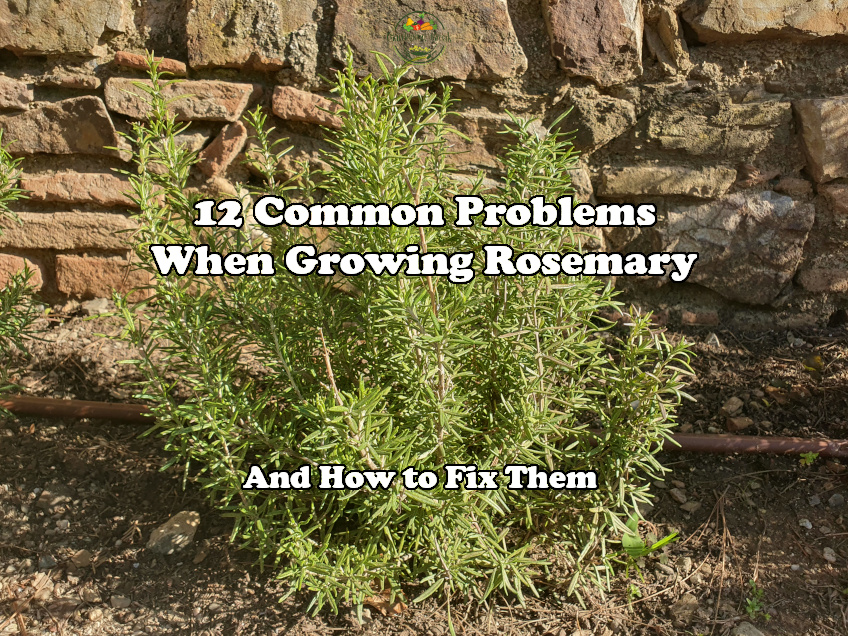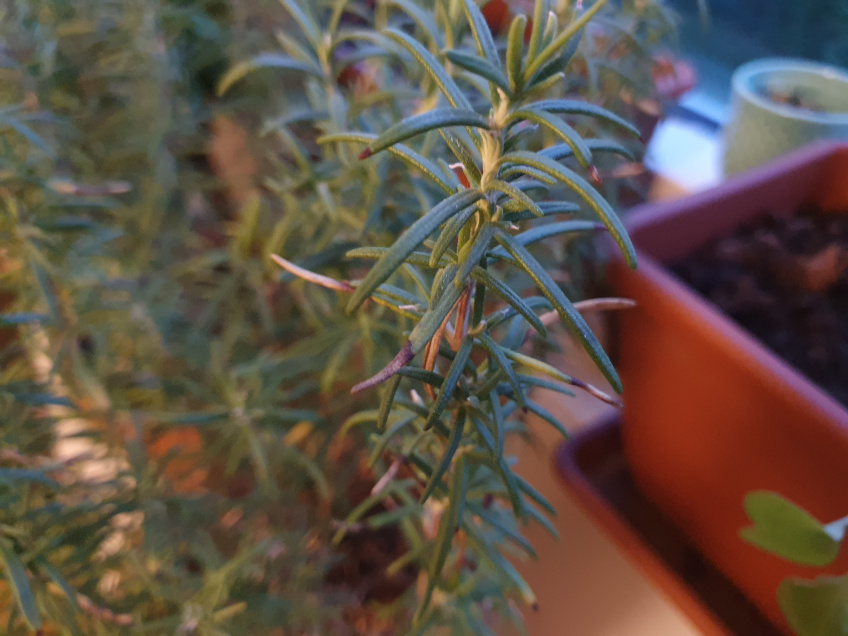Rosemary is one of my absolute favorite herbs to grow. It smells and tastes wonderful and usually doesn’t require much maintenance. That said, there are several potential problems you can run into when growing it. I have had to deal with most of these problems many times, so know exactly how to solve them.
To make it as easy as possible for you to solve the problem you are having with your rosemary plants, I have made a list of many different common problems and explained how you solve them and avoid them in the future.

1. Your Rosemary Is Not Growing at All
One of the most common questions I have been asked by friends and family about growing rosemary is why their plants aren’t growing.
Of course, there is no single answer to that question but it is usually caused by one of a few problems which can definitely be solved. To make it as easy as possible for you to figure out why your rosemary isn’t growing, I have written another article, which you can find on this link, where I help you identify and solve the problem.
Keep in mind that rosemary plants grow very slowly in the beginning and it can easily seem like nothing is happening. If your plant is about 5 inches (12.7 cm) tall and doesn’t appear to grow at all, however, something is likely wrong.
2. Your Rosemary Is Rootbound
A very common issue with potted rosemary is that the plant becomes rootbound, which means that its roots fill out the entire pot. When that happens, the plant can’t obtain nutrients nearly as efficiently as it used to, which will cause it to grow slower and slower until it stops entirely and dies.
Luckily, saving a rootbound rosemary plant is not that complicated. All you have to do is transplant it into a larger pot. I have a guide for that on this link where I share photos of me doing each of the steps so you can easily do it yourself.
The easiest way to find out if your rosemary is rootbound is to carefully lift it a little bit out of its pot. If you don’t see much soil but instead mostly roots, it is time to transplant it.
3. Overwatering
In my experience, rosemary doesn’t need nearly as much water as a lot of other popular garden plants. This means that less work is needed, which is great, but it also means that people often give their rosemary too much water. I have certainly done it myself and I know a bunch of people who have done it too.
Wilting and yellowing leaves are common signs of overwatering, but there are also other signs you should know about. So if you suspect that you might have been overwatering your rosemary, I recommend that you head over to the article on this link, where I share all the signs to look out for as well as explain how to save your plant and how to avoid the problem in the future.
4. Root rot
Root rot means, as the name indicates, that a plant’s roots are rotting. There are a couple of potential reasons why this happens, but the most common reason by far is overwatering.
If most or all of the roots on your rosemary are rotten, the plant is very unlikely to survive. If the roots are just starting to rot, however, there is still hope but you have to react now.
The most important thing you can do to avoid root rot is to water your rosemary correctly. I have a guide on this link where I explain how you can figure out exactly when you should water your specific rosemary plants and how much water they need.
5. Mold on the Soil or Foliage
A problem I have had with my rosemary a handful of times is that mold started to appear either on the soil or on the foliage. When that happens, you have to act fast.
It can happen for a few reasons but the most common are overwatering, poor airflow, or mold spreading from other nearby plants.
When I have had mold on my rosemary, it has either been because of overwatering or poor airflow. I have managed to solve it several times by moving my rosemary to a spot with better airflow and by adjusting my watering.
If there is mold on parts of your rosemary plant, you should remove the affected foliage as soon as possible. If there is mold on the soil, head over to the article on this link where I cover the issue and how to solve it.
6. Foliage Turning Yellow or Brown

It is almost inevitable that some of the foliage on your rosemary turn yellow or brown at some point. There are several potential problems that can cause this to happen and while some of them are nothing to worry about and only affect small areas, some of them are serious and have to be solved.
Yellowing or brown and dry leaves can be a result of overwatering but another common cause is overfertilization.
Rosemary plants don’t need the same nutrient-rich soil as basil, tomatoes, cucumbers, peppers, and many other popular garden plants. If you plant rosemary in too nutrient-rich soil, the leaves will start to look scorched. That is precisely what happened to my rosemary plant in the photo above.
7. Leaves Drying Out
It is not uncommon to see leaves on your rosemary plants drying out and looking more pale than the rest of the dark green leaves. I have seen this several times and while it doesn’t have to be a big problem, it can certainly turn into one if the problem starts to spread and affect large parts of the plant.
Of course, lack of water is one of the reasons why this can happen but it is actually also very common that overwatering is the cause. The reason why too much water can cause a plant to dry out is that it damages the roots and thereby the plant’s ability to obtain water and nutrients.
So the solution is to adjust your watering. I have a guide for that on this link.
8. Powdery Mildew
Powdery mildew is a very common problem for gardeners and rosemary can also fall victim to the infectious fungal disease, which appears as white mold-looking spots on the leaves.
In my experience, the easiest way to get rid of powdery mildew is to simply remove the part of the plant that is infected, but if most of the plant is infected, you should not do that. Instead, treat it by spraying it with a mix of one tablespoon of baking soda, a half tablespoon of liquid soap, and a gallon (3.8 liters) of water
If there are any unaffected stems on your plant, you can cut them off and grow them as new plants somewhere away from the parent plant to reduce the risk of the problem spreading. I have a guide for growing rosemary from cuttings here.
Powdery mildew thrives in warm and humid environments with poor airflow, so the best way to avoid it is to provide good airflow and make sure you are not overwatering your rosemary.
9. Aphids

Aphids are the tiny, usually light green, insects you see in the photo above. Because of their tiny size, a few of them won’t cause much damage to a rosemary plant but they spread rapidly and can quickly become a problem, not only for your rosemary but also for other nearby plants.
Aphids are large enough to be visible without a magnifying glass, but also small enough to be difficult to spot unless there are a lot of them so look closely.
A common sign that aphids are attacking your plants is that tiny yellow or pale spots start to appear on the foliage. This happens because the aphids consume the sap from the leaves.
The easiest way I have found to get rid of aphids is to make a mix of a small amount of natural brown soap and water and spray it all over the plant as well as the ground. Repeat that several times over the course of a couple of days and then keep a close eye on the plant afterwards. I also know that people have good results with neem oil.
10. Spittlebugs
If you have ever found a seemingly unexplainable small ball of what appears to be spit on one of your rosemary plants, chances are your plant is being visited by spittlebugs.
Spittlebugs generally don’t cause that much damage to woody plants like rosemary but the spit-like substance they leave on the plant is certainly not very appetizing.
The easiest way to get rid of spittlebugs and the foam or spit-like substance is to spray the plant with water.
11. Whiteflies
Whiteflies are, as the name indicates, tiny white flies that can appear on rosemary plants in large numbers. They can multiply quickly, so keep an eye out for them.
As with aphids, the easiest way to get rid of whiteflies is to use neem oil or a mix of a bit of natural brown soap and water and spray it all over the plant.
12. Rosemary Beetles
Rosemary beetles are about a quarter of an inch (about 6-7 mm) long and have colorful stripes along their bodies.
Generally speaking, rosemary beetles don’t pose much of a threat to your rosemary. In this article, the Royal Horticulture Society recommends that you merely view them as a colorful addition to the garden and a part of the biodiversity of a healthy garden.
If you do want to get rid of them, though, removing them by hand is probably the most effective way.

